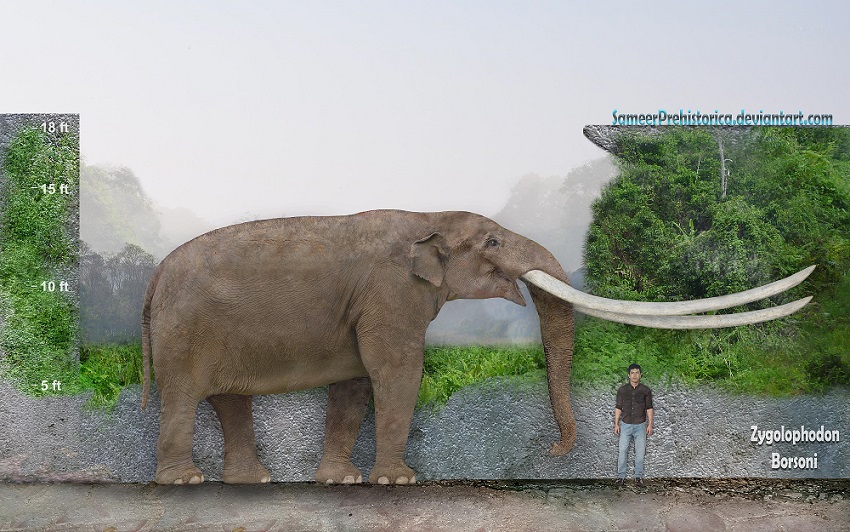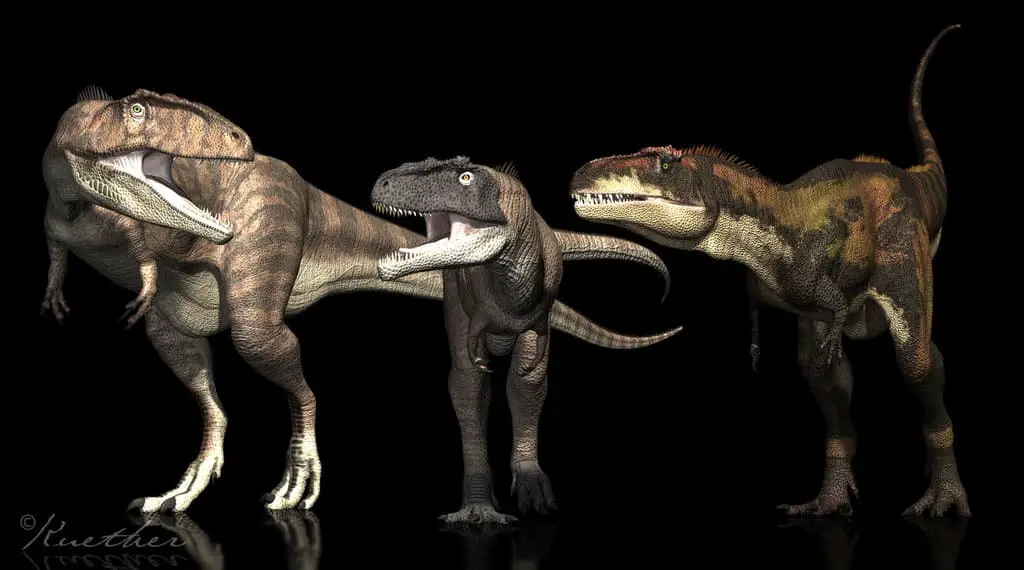Post by dinosauria101 on Mar 30, 2019 9:12:58 GMT 5
Mammut borsoni
Mastodons (Greek: μαστός "breast" and ὀδούς, "tooth") are any species of extinct mammutid proboscideans in the genus Mammut, distantly related to elephants, that inhabited North and Central America during the late Miocene or late Pliocene up to their extinction at the end of the Pleistocene 10,000 to 11,000 years ago. Mastodons lived in herds and were predominantly forest dwelling animals that fed on a mixed diet obtained by browsing and grazing with a seasonal preference for browsing, similar to living elephants. Modern reconstructions based on partial and skeletal remains reveal that mastodons were very similar in appearance to elephants and, to a lesser degree, mammoths, though not closely related to either one. Compared to mammoths, mastodons had shorter legs, a longer body and were more heavily muscled, a build similar to that of the current Asian Elephants. M. borsoni, is known from 30–40-year-old males that were 3.9–4.1 metres (12.8–13.5 ft) tall and 14–16 tonnes (14–16 long tons; 15–18 short tons) in weight. A large species Mammut during the Pilocene, that was fossil recond in Europe and Asia. According to Greek fossils, we know Mammut borsoni shoulder high about 3.5 m, incisors about 4.3 m. In China,also found Mammut borsoni, but most material is only single molar, the best material is a jaw.
![]()

Mapusaurus roseae (pack of 3)
Mapusaurus ("Earth lizard") was a giant carnosaurian, Carcharodontosaurid dinosaur from the early Late Cretaceous (late Cenomanian to early Turonian stage) of what is now Argentina and possibly Chile. It was roughly similar in size to its close relative Giganotosaurus, with the largest known individuals estimated as about 10.2 metres (33 ft) in length or more and weighing about 3 metric tons (3.3 short tons). The longest individual for which Coria and Currie (2006) provided a concrete estimate in Table 1 (apendix lll) is the animal to which femur MCF-PVPH-208.203 belonged; this individual is estimated as 10.2 metres (33 ft) long. The fossil remains of Mapusaurus were discovered in a bone bed containing at least seven individuals of various growth stages. Coria and Currie speculated that this may represent a long term, possibly coincidental accumulation of carcasses (some sort of predator trap) and may provide clues about Mapusaurus behavior. Other known theropod bone beds include the Allosaurus-dominated Cleveland-Lloyd Dinosaur Quarry of Utah, an Albertosaurus bone bed from Alberta and a Daspletosaurus bone bed from Montana. Paleontologist Rodolfo Coria, of the Museo Carmen Funes, contrary to his published article, repeated in a press-conference earlier suggestions that this congregation of fossil bones may indicate that Mapusaurus hunted in groups and worked together to take down large prey, such as the immense sauropod Argentinosaurus. If so, this would be the first substantive evidence of gregarious behavior by large theropods other than Tyrannosaurus, although whether they might have hunted in organized packs (as wolves do) or simply attacked in a mob, is unknown.
NOTE: Mapusaurus was actually much bigger than in the OP, up to 13-14 meters and 7-8 tons

Credit to Wikipedia
Mastodons (Greek: μαστός "breast" and ὀδούς, "tooth") are any species of extinct mammutid proboscideans in the genus Mammut, distantly related to elephants, that inhabited North and Central America during the late Miocene or late Pliocene up to their extinction at the end of the Pleistocene 10,000 to 11,000 years ago. Mastodons lived in herds and were predominantly forest dwelling animals that fed on a mixed diet obtained by browsing and grazing with a seasonal preference for browsing, similar to living elephants. Modern reconstructions based on partial and skeletal remains reveal that mastodons were very similar in appearance to elephants and, to a lesser degree, mammoths, though not closely related to either one. Compared to mammoths, mastodons had shorter legs, a longer body and were more heavily muscled, a build similar to that of the current Asian Elephants. M. borsoni, is known from 30–40-year-old males that were 3.9–4.1 metres (12.8–13.5 ft) tall and 14–16 tonnes (14–16 long tons; 15–18 short tons) in weight. A large species Mammut during the Pilocene, that was fossil recond in Europe and Asia. According to Greek fossils, we know Mammut borsoni shoulder high about 3.5 m, incisors about 4.3 m. In China,also found Mammut borsoni, but most material is only single molar, the best material is a jaw.

Mapusaurus roseae (pack of 3)
Mapusaurus ("Earth lizard") was a giant carnosaurian, Carcharodontosaurid dinosaur from the early Late Cretaceous (late Cenomanian to early Turonian stage) of what is now Argentina and possibly Chile. It was roughly similar in size to its close relative Giganotosaurus, with the largest known individuals estimated as about 10.2 metres (33 ft) in length or more and weighing about 3 metric tons (3.3 short tons). The longest individual for which Coria and Currie (2006) provided a concrete estimate in Table 1 (apendix lll) is the animal to which femur MCF-PVPH-208.203 belonged; this individual is estimated as 10.2 metres (33 ft) long. The fossil remains of Mapusaurus were discovered in a bone bed containing at least seven individuals of various growth stages. Coria and Currie speculated that this may represent a long term, possibly coincidental accumulation of carcasses (some sort of predator trap) and may provide clues about Mapusaurus behavior. Other known theropod bone beds include the Allosaurus-dominated Cleveland-Lloyd Dinosaur Quarry of Utah, an Albertosaurus bone bed from Alberta and a Daspletosaurus bone bed from Montana. Paleontologist Rodolfo Coria, of the Museo Carmen Funes, contrary to his published article, repeated in a press-conference earlier suggestions that this congregation of fossil bones may indicate that Mapusaurus hunted in groups and worked together to take down large prey, such as the immense sauropod Argentinosaurus. If so, this would be the first substantive evidence of gregarious behavior by large theropods other than Tyrannosaurus, although whether they might have hunted in organized packs (as wolves do) or simply attacked in a mob, is unknown.
NOTE: Mapusaurus was actually much bigger than in the OP, up to 13-14 meters and 7-8 tons

Credit to Wikipedia




